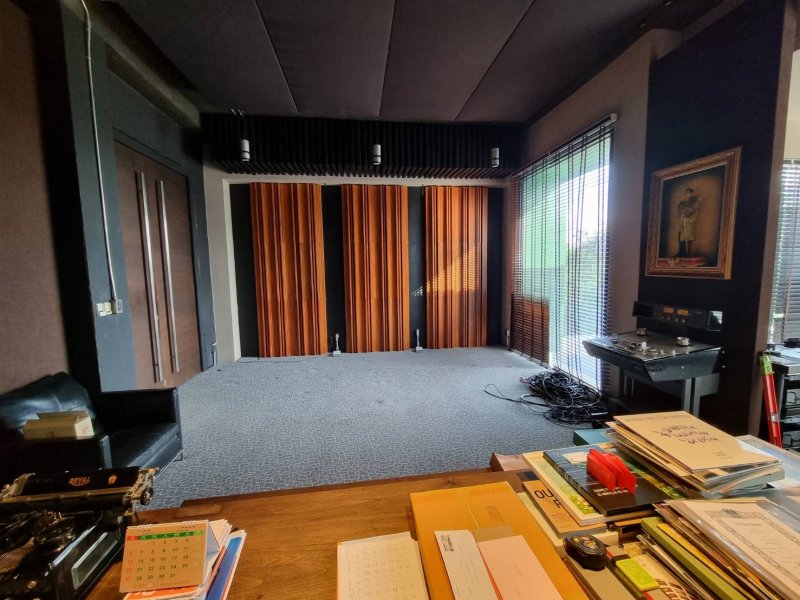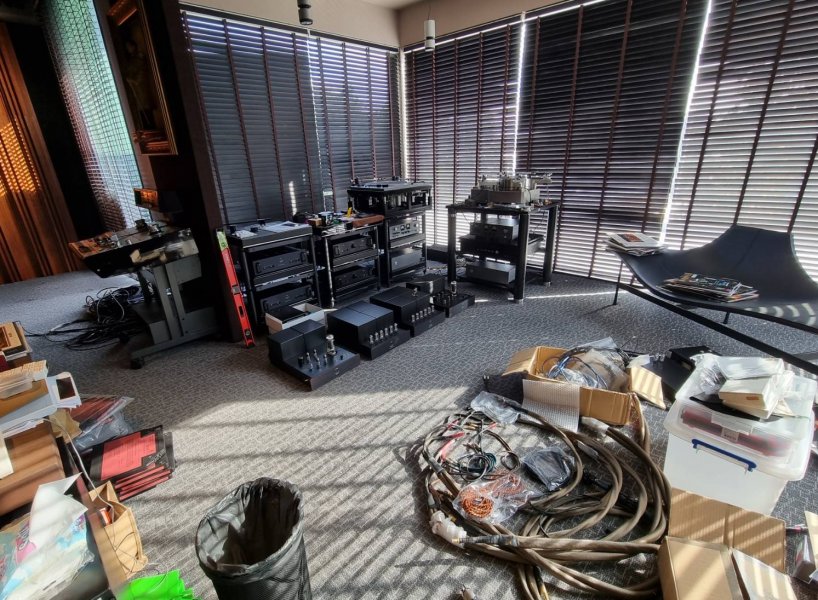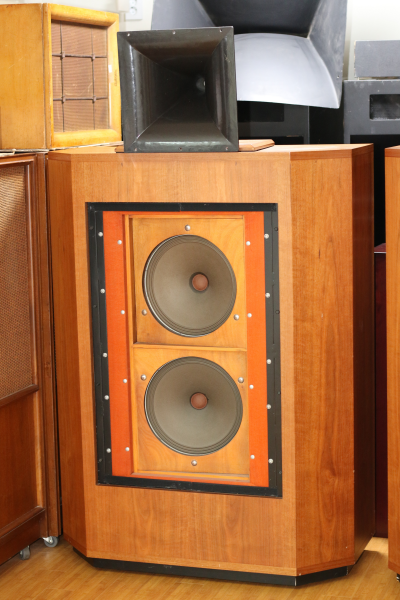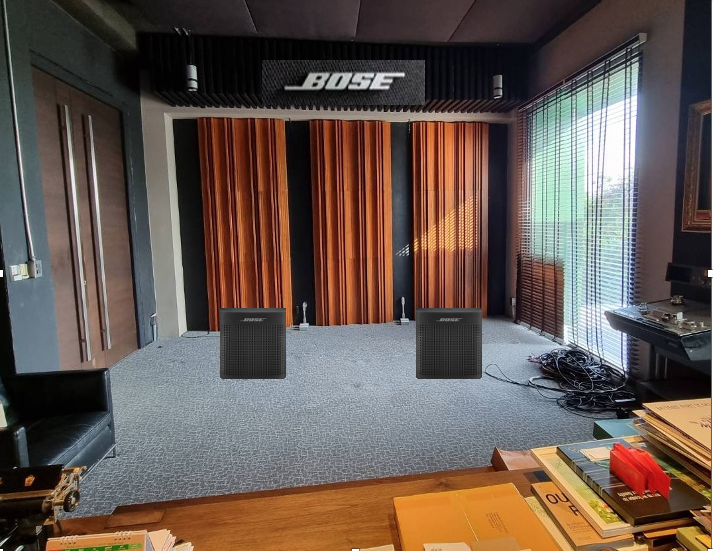Very clever solution!You are welcome Bill. I installed a steel column under each of the four legs of my rack going through the basement down to the house foundation. There are no issues.
I apologize to Tang for taking the discussion away from his system and David’s Turntable.
American Sound AS-2000 Installations- Far East (Tango)
- Thread starter ddk
- Start date
You are using an out of date browser. It may not display this or other websites correctly.
You should upgrade or use an alternative browser.
You should upgrade or use an alternative browser.
Nothing is happening just yet. David's speaker system is rested in my warehouse still in the boxes. The Cessaro Gamma II are moved to my friend's house because I have no space. My Studer and Lamm pre are back from repair. Hardware are all ready for setup. Just waiting for me to get back to audio. I actually feel like I have "the" system and a peace of mind. It is in my hand so I am doing other things. My crazy French friend had his Bionor setup kept asking me if I have heard the sound of the "small dick" Eurodyn yet. He said his Bionor is the Big Dick the best speakers he heard by his words. Now he wants to switch from Kondo to Lamm.




Last edited:
The Tango-sphere will never be the same. I was kind of fond of the old set up, from a strictly internet point of view.
A very lucky friend… must be exciting coming into the holidays with a bold new world ahead.Nothing is happening just yet. David's speaker system is rested in my warehouse still in the boxes. The Cessaro Gamma II are moved to my friend's house because I have no space. My Studer and Lamm pre are back from repair. Hardware are all ready for setup. Just waiting for me to get back to audio. I actually feel like I have "the" system and a peace of mind. It is in my hand so I am doing other things. My crazy French had his Bionor setup kept asking me if I have heard the sound of the "small dick" Eurodyn yet. He said his Bionor is the Big Dick the best speakers he heard by his words. Now he wants to switch from Kondo to Lamm.
View attachment 100909
View attachment 100910
Time to show him YOURS!Nothing is happening just yet. David's speaker system is rested in my warehouse still in the boxes. The Cessaro Gamma II are moved to my friend's house because I have no space. My Studer and Lamm pre are back from repair. Hardware are all ready for setup. Just waiting for me to get back to audio. I actually feel like I have "the" system and a peace of mind. It is in my hand so I am doing other things. My crazy French had his Bionor setup kept asking me if I have heard the sound of the "small dick" Eurodyn yet. He said his Bionor is the Big Dick the best speakers he heard by his words. Now he wants to switch from Kondo to Lamm.
View attachment 100909
View attachment 100910
david
Size doesnt matter as long as it is still soft. Wanting to switch to Lamm means his is still soft. No subs also means not hard as it should.Time to show him YOURS!
david
For full range maturity he needs to a grow a pair for his Big D!Size doesnt matter as long as it is still soft. Wanting to switch to Lamm means his is still soft. No subs also means not hard as it should.
david
Last edited:
For small private listening rooms, the big auditorium baffles aren't necessary at all. They don't fit the most private rooms at all and are much oversized. Those were designs for cinemas or big venues with hundreds of people attending a listening session.He said his Bionor is the Big Dick the best speakers he heard by his words. Now he wants to switch from Kondo to Lamm.
It's possible to shrink it to more user friendly sizes easily. Who needs to have a big dick audio system, the adolescents with deep pockets?
Come on man, we are adults and should behave like those, no teenagers. It's all about quality in sound reproduction, not size for no reason.
Once I auditioned a big horn speaker, but even this speaker could fit into a bigger than average living room. Those old speakers are not about the lowest octave of listening like its modern these days. Their qualities lie in different aspects of sound. Sound, no modern speaker can deliver
anymore.

Last edited:
Nothing is happening just yet. David's speaker system is rested in my warehouse still in the boxes. The Cessaro Gamma II are moved to my friend's house because I have no space. My Studer and Lamm pre are back from repair. Hardware are all ready for setup. Just waiting for me to get back to audio. I actually feel like I have "the" system and a peace of mind. It is in my hand so I am doing other things. My crazy French friend had his Bionor setup kept asking me if I have heard the sound of the "small dick" Eurodyn yet. He said his Bionor is the Big Dick the best speakers he heard by his words. Now he wants to switch from Kondo to Lamm.
View attachment 100909
View attachment 100910

Last edited:
Been experimenting with all sorts of baffles and horn bass bins a for very long time, at least 20 years, even built 6 more baffles for @Tango 's project, while I agree with you on their special qualities you're totally wrong about the baffle size and wood quality Walter. Both have a huge impact on the final sound of these speakers including the mids and highs, you can only hope to guess what such speakers are capable of miniaturized as above but not touch, size matters!For small private listening rooms, the big auditorium baffles aren't necessary at all. They don't fit the most private rooms at all and are much oversized. Those were designs for cinemas or big venues with hundreds of people attending a listening session.
It's possible to shrink it to more user friendly sizes easily. Who needs to have a big dick audio system, the adolescents with deep pockets?
Come on man, we are adults and should behave like those, no teenagers. It's all about quality in sound reproduction, not size for no reason.
Once I auditioned a big horn speaker, but even this speaker could fit into a bigger than average living room. Those old speakers are not about the lowest octave of listening like its modern these days. Their qualities lie in different aspects of sound. Sound, no modern speaker can deliver
anymore.
View attachment 100919
david
Last edited:
David, there might be a misunderstanding in my post.
You won't find anything in my text that denies the importance of the wood quality concerning those old resonant speaker designs.
I've studied those old designs of the past in depth and for years because as a DIY, I'm interested in this field of mostly forgotten knowledge about resonant wood speaker designs.
And that means, I've studied it longer than two decades, more than three decades ago I first was initiated to this mysterious quality of sound generated by those speakers. I made much approach to audition some excellent examples of those speakers, so I'm truly aware of their qualities, shortcomings and sound.
With the importance of big baffles for low frequency reproduction, I'm with you absolutely.
The main question remains, were those antique audio speakers designed to play, lets say, 20 Hz with a relevant SPL (Sound Pressure Level per speaker)?
If you look at the data of the main power amps for those old speaker designs with big baffles, one clearly sees that the amps had a relevant frequency response not below 50 Hz at that time. They struggled hard with the low and high frequency response, because of the limited quality of their audio transformers. Every data book on audio transformers tells the whole story.
For the first generation of cinema amps, the WE 43A, Western did not state a frequency response at all.
But for the third generation, the 124 series of power amps, they stated 50-10Kz +-1dB. That was the situation in the 1950's, and it had improved from the original state of frequency response of tube amps in the late 1920's greatly.
This is why the speakers had to be that big or they made use of big baffles, otherwise, they weren't able to reproduce low freqencies at all.
Even a famous speaker design of that time, the WE 728B, did not produce Sound Pressure levels below 60 Hz.
With a modern power amp, having a nearly linear freq. response from 20-20KHz, that full frequency range speaker doesn't need big baffles to compensate for a limited frequency response of the amp anymore. And thats even true for modern tube amps as well.
So what you achieve, combining speaker designs invented for compensating the limiting frequency response of the amps of those days, with modern, linear amp designs, is just an overpronounced low frequency response.
That is even more true, when using big baffle speakers, designed to operate in big venues or cinemas but being completely oversized for the listening situation in personal living rooms of much smaller size and different shape.
You may write that I'm completely false on this topic, but personally I do know what an Altec VOTT horn speaker can do in a living room environment. One will have a hard time to control that energies in that room. Most installations I've heard struggled hard with the problems.
As modern technologies present a solution for those situations, some audiophiles went further on to install a digital speaker management system to cover those problems, they never get rid off in the analog domain.
But even that creates new, but different problems.
So for me, the room size has to match the speaker size and the room should be able to accept and absorb the huge energies a horn speaker is able to throw into the room.
An old, original speaker design, combined with a modern amp in a much too small room can't deliver an ideal sound result. And that's not only my opinion, that's simple physics.
You won't find anything in my text that denies the importance of the wood quality concerning those old resonant speaker designs.
I've studied those old designs of the past in depth and for years because as a DIY, I'm interested in this field of mostly forgotten knowledge about resonant wood speaker designs.
And that means, I've studied it longer than two decades, more than three decades ago I first was initiated to this mysterious quality of sound generated by those speakers. I made much approach to audition some excellent examples of those speakers, so I'm truly aware of their qualities, shortcomings and sound.
With the importance of big baffles for low frequency reproduction, I'm with you absolutely.
The main question remains, were those antique audio speakers designed to play, lets say, 20 Hz with a relevant SPL (Sound Pressure Level per speaker)?
If you look at the data of the main power amps for those old speaker designs with big baffles, one clearly sees that the amps had a relevant frequency response not below 50 Hz at that time. They struggled hard with the low and high frequency response, because of the limited quality of their audio transformers. Every data book on audio transformers tells the whole story.
For the first generation of cinema amps, the WE 43A, Western did not state a frequency response at all.
But for the third generation, the 124 series of power amps, they stated 50-10Kz +-1dB. That was the situation in the 1950's, and it had improved from the original state of frequency response of tube amps in the late 1920's greatly.
This is why the speakers had to be that big or they made use of big baffles, otherwise, they weren't able to reproduce low freqencies at all.
Even a famous speaker design of that time, the WE 728B, did not produce Sound Pressure levels below 60 Hz.
With a modern power amp, having a nearly linear freq. response from 20-20KHz, that full frequency range speaker doesn't need big baffles to compensate for a limited frequency response of the amp anymore. And thats even true for modern tube amps as well.
So what you achieve, combining speaker designs invented for compensating the limiting frequency response of the amps of those days, with modern, linear amp designs, is just an overpronounced low frequency response.
That is even more true, when using big baffle speakers, designed to operate in big venues or cinemas but being completely oversized for the listening situation in personal living rooms of much smaller size and different shape.
You may write that I'm completely false on this topic, but personally I do know what an Altec VOTT horn speaker can do in a living room environment. One will have a hard time to control that energies in that room. Most installations I've heard struggled hard with the problems.
As modern technologies present a solution for those situations, some audiophiles went further on to install a digital speaker management system to cover those problems, they never get rid off in the analog domain.
But even that creates new, but different problems.
So for me, the room size has to match the speaker size and the room should be able to accept and absorb the huge energies a horn speaker is able to throw into the room.
An old, original speaker design, combined with a modern amp in a much too small room can't deliver an ideal sound result. And that's not only my opinion, that's simple physics.
Last edited:
I replied directly to your comment, no misunderstanding.David, there might be a misunderstanding in my post.
You won't find anything in my text that denies the importance of the wood quality concerning those old resonant speaker designs.
For small private listening rooms, the big auditorium baffles aren't necessary at all.
... It's possible to shrink it to more user friendly sizes easily. Who needs to have a big dick audio system, the adolescents with deep pockets?
Come on man, we are adults and should behave like those, no teenagers. It's all about quality in sound reproduction, not size for no reason.
I appreciate your experience but I own and live with these particular designs for over two decades, direct experience not study from a distance.I've studied those old designs of the past in depth and for years because as a DIY, I'm interested in this field of mostly forgotten knowledge about resonant wood speaker designs.
And that means, I've studied it longer than two decades, more than three decades ago I first was initiated to this mysterious quality of sound generated by those speakers. I made much approach to audition some excellent examples of those speakers, so I'm truly aware of their qualities, shortcomings and sound.
Actually I was commenting on and concerned with mid and high frequency response more than bass extension, which is also very important but not the issue in this build.With the importance of big baffles for low frequency reproduction, I'm with you absolutely.
....the baffle size and wood quality Walter. Both have a huge impact on the final sound of these speakers including the mids and highs, you can only hope to guess what such speakers are capable of miniaturized as above but not touch, size matters!
david
The main question remains, were those antique audio speakers designed to play, lets say, 20 Hz with a relevant SPL (Sound Pressure Level per speaker)?
If you look at the data of the main power amps for those old speaker designs with big baffles, one clearly sees that the amps had a relevant frequency response not below 50 Hz at that time. They struggled hard with the low and high frequency response, because of the limited quality of their audio transformers. Every data book on audio transformers tells the whole story.
For the first generation of cinema amps, the WE 43A, Western did not state a frequency response at all.
But for the third generation, the 124 series of power amps, they stated 50-10Kz +-1dB. That was the situation in the 1950's, and it had improved from the original state of frequency response of tube amps in the late 1920's greatly.
This why the speakers had to be that big or they made use of big baffles, otherwise, they weren't able to reproduce low freqencies at all.
Even a famous speaker design of that time, the WE 728B, did not produce Sound Pressure levels below 60 Hz.
With a modern power amp, having a nearly linear freq. response from 20-20KHz, that full frequency range speaker doesn't need big baffles to compensate for a limited frequency response of the amp anymore. And thats even true for modern tube amps as well.
Maybe if you don't know what you're doing, certainly not my experience with these speakers.So what you achieve, combining speaker designs invented for compensating the limiting frequency response of the amps of those days, with modern, linear amp designs, is just an overpronounced low frequency response.
That is even more true, when using big baffle speakers, designed to operate in big venues or cinemas and not being completely oversized for the listening situation in personal living rooms of much smaller size and different shape.
Most installations I hear struggle hard with any speaker, nature of the beast. This is where knowledge and experience comes into play.You may write that I'm completely false on this topic, but personally I do know what an Altec VOTT horn speaker can do in a living room environment. One will have a hard time to control that energies in that room. Most installations I've heard struggled hard with the problems.
We're discussing Siemens Klangfilm speakers, two very specific models using modern electronics there's no relevant point generalizing about different unrelated designs and prewar electronics.As modern technologies present a solution for those situations, some audiophiles went further to install a digital speaker management system to cover those problems, they never get rid off in the analog domain.
But even that creates new, but different problems.
So for me, the room size has to match the speaker size and the room should be able to accept and absorb the huge energies a horn speaker is able to throw into the room.
An old, original speaker design, combined with a modern amp in a much too small room can't deliver an ideal sound result. And that's not only my opinion, that's simple physics.
You can overdrive a space with any speaker doesn't have to be an open baffle theater speaker, many have been using them in domestic environments with excellent results, even large WE horn systems. We probably have a difference of opinion about too small a space as well.
david
Last edited:
Thats just mean!I don't know why there is such a delay in setting them up. They're not that big. Oh, wait, I mis-spoke. Looks like they're up and running. And since they're bluetooth, you can throw all those wires away. Enjoy!!
View attachment 100948
David, there might be a misunderstanding in my post.
You won't find anything in my text that denies the importance of the wood quality concerning those old resonant speaker designs.
I've studied those old designs of the past in depth and for years because as a DIY, I'm interested in this field of mostly forgotten knowledge about resonant wood speaker designs.
And that means, I've studied it longer than two decades, more than three decades ago I first was initiated to this mysterious quality of sound generated by those speakers. I made much approach to audition some excellent examples of those speakers, so I'm truly aware of their qualities, shortcomings and sound.
With the importance of big baffles for low frequency reproduction, I'm with you absolutely.
The main question remains, were those antique audio speakers designed to play, lets say, 20 Hz with a relevant SPL (Sound Pressure Level per speaker)?
If you look at the data of the main power amps for those old speaker designs with big baffles, one clearly sees that the amps had a relevant frequency response not below 50 Hz at that time. They struggled hard with the low and high frequency response, because of the limited quality of their audio transformers. Every data book on audio transformers tells the whole story.
For the first generation of cinema amps, the WE 43A, Western did not state a frequency response at all.
But for the third generation, the 124 series of power amps, they stated 50-10Kz +-1dB. That was the situation in the 1950's, and it had improved from the original state of frequency response of tube amps in the late 1920's greatly.
This is why the speakers had to be that big or they made use of big baffles, otherwise, they weren't able to reproduce low freqencies at all.
Even a famous speaker design of that time, the WE 728B, did not produce Sound Pressure levels below 60 Hz.
With a modern power amp, having a nearly linear freq. response from 20-20KHz, that full frequency range speaker doesn't need big baffles to compensate for a limited frequency response of the amp anymore. And thats even true for modern tube amps as well.
So what you achieve, combining speaker designs invented for compensating the limiting frequency response of the amps of those days, with modern, linear amp designs, is just an overpronounced low frequency response.
That is even more true, when using big baffle speakers, designed to operate in big venues or cinemas but being completely oversized for the listening situation in personal living rooms of much smaller size and different shape.
You may write that I'm completely false on this topic, but personally I do know what an Altec VOTT horn speaker can do in a living room environment. One will have a hard time to control that energies in that room. Most installations I've heard struggled hard with the problems.
As modern technologies present a solution for those situations, some audiophiles went further on to install a digital speaker management system to cover those problems, they never get rid off in the analog domain.
But even that creates new, but different problems.
So for me, the room size has to match the speaker size and the room should be able to accept and absorb the huge energies a horn speaker is able to throw into the room.
An old, original speaker design, combined with a modern amp in a much too small room can't deliver an ideal sound result. And that's not only my opinion, that's simple physics.
The baffles don't "compensate" for lack of low end in the amps. That's a totally misleading characterization of the reality.
Under 100hz everything has to be over 3ft and growing the lower you go, to have a horn effect (not just flat baffle). None of them have that. Even if they did the drivers don't play very low. The baffle size prevents cancellation with the back wave. The size of the baffle determines what frequencies won't be getting cancellation. The drivers likely work better in OB/IB config due to their parameters, such as a Q more suited to it. There simply is nothing to do with acoustical gain in the lower frequencies - especially in relation to the amplifiers.
I simply don't understand why there is an insistent claim about voodoo with speaker... "energies" aka room gain... Very normal standard stuff that is simple to deal with and totally unrelated to dumb shit like "pressurizing" comments.
Been experimenting with all sorts of baffles and horn bass bins a for very long time, at least 20 years, even built 6 more baffles for @Tango 's project,
After Tang is up and running, I would love for you to write a thread about the project, of course w/out trade secrets. I'll go so far as asking (please) for a Forum:
David Karmeli Discusses 5 Reference Speakers Forum
Bionor/Eurodyne
Vitavox
JBL ?
TAD ?
?
?
... whatever you want to write about.
We’ll see it’s mostly a question of time I also have to finish this turntable series.After Tang is up and running, I would love for you to write a thread about the project, of course w/out trade secrets. I'll go so far as asking (please) for a Forum:
David Karmeli Discusses 5 Reference Speakers Forum
Bionor/Eurodyne
Vitavox
JBL ?
TAD ?
?
?
... whatever you want to write about.
david
After Tang is up and running, I would love for you to write a thread about the project, of course w/out trade secrets. I'll go so far as asking (please) for a Forum:
David Karmeli Discusses 5 Reference Speakers Forum
Bionor/Eurodyne
Vitavox
JBL ?
TAD ?
?
?
... whatever you want to write about.
I love this idea. Perhaps Mitsubishi Diatone.
Similar threads
- Replies
- 483
- Views
- 68K
- Replies
- 33
- Views
- 16K
- Replies
- 30
- Views
- 25K
- Replies
- 75
- Views
- 33K
| Steve Williams Site Founder | Site Owner | Administrator | Ron Resnick Site Owner | Administrator | Julian (The Fixer) Website Build | Marketing Managersing |








